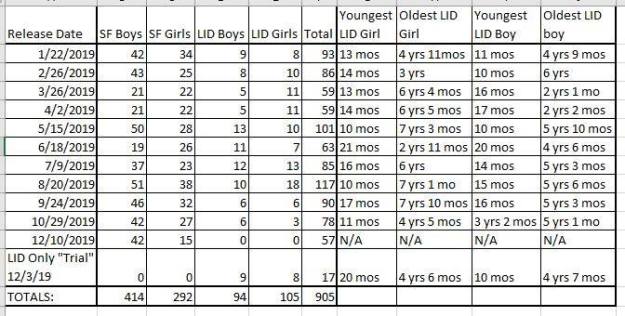In July 2017, the CCCWA announced an end to the partnership system. Any files which reached the provincial level of civil affairs by December 31, 2017 would still be designated to partner agencies. The general expectation is that the amount of new files posted the shared list would increase throughout 2018 as the partnership files came to an end. You can see on this chart at Red Thread Advocates that there was an initial jump in shared list numbers in July 2017 with a steady increase thereafter.
I was sent a summary of shared list releases from 2017 and 2018. Here is the information from 2017:

There was no real increase in the amount of files released to the shared list by the end of 2017. However, by the end of 2018 the number of files released to the shared list had doubled.

That’s a lot of data to take in, so here are a few quick points that can be drawn.
- In 2018, file releases remained approximately monthly.
- The amount of files released to the shared list in 2018 was double the number released in 2017.
- Other than one abnormally large file release in 2017, the amount of files released was generally around 30. Beginning in March 2018, there were never fewer than 50 files released in a month.
- However, this is still not as many as you would expect to see if all files were being added to the shared list. In 2017, a single large agency could receive 30 partnership files in a month.
- In 2017 the number of LID girls per release ranged from 0-5, while in 2018 it was 0-12. Even with all new files going to the shared list, there were never more than 12 LID girl files released for all of the families waiting around the world.
- There has been much speculation that the number of LID girl files is decreasing. There were more than twice as many LID girl files released in 2018 than in 2017. But again, this is not as many files as you would have expected to see if all of the partnership files were being released to the shared list. While we don’t have any way of knowing the total number of LID girl files prepared by the CCCWA previously, it seems safe to speculate that the overall number is down even though the amount posted to the shared list has increased.
- The age range of LID files has remained consistent. In 2017, LID girls were as young as 11 months and as old as 8 years. In 2018, the youngest was 10 months and the oldest was 8 years.
- There continues to be more boy files released, both special focus and LID. In addition, girls are designated LID at older ages than boys. In general, LID boys are under age 3, though they can be as old as 5 (with a single boy in the past two years being age 7).
It’s impossible to know what the future holds for the China program. I think it is still stable and a good choice for those families open to a moderate amount of needs, to children older than 3, and especially those open to adopting a boy. If you are a family that is only open to adopting a very young girl with minor needs, I would hesitate before signing with an agency. There were only 70 LID girl files released in 2018 and we know that some of them were for girls as old as 8. If you choose one of the most popular agencies, I can guarantee you that they have more than 70 families waiting in line ahead of you. There is no reason to think that the number of LID files of young girls will increase. In fact, there is a lot of anecdotal evidence that fewer files are being prepared in general, particularly after the change in orphanage donation requirement.
If you are starting the process now, it’s important that you choose an agency which is financially stable, but also make sure you ask about their number of waiting families. In the end, your child profile will be the biggest factor in your wait time to be matched.






